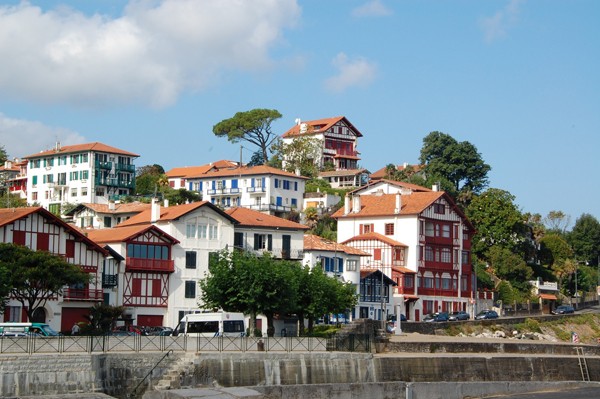France vs Spain: Living Costs

On a recent short vacation in northwest Spain, I couldn’t help but notice the string of French cars trailing into the supermarket parking lots. A similar story seemed to be playing out in the gas stations too, and it didn’t require an economics degree from Harvard to figure out why. The cost of living is considerably cheaper in Spain than in France, and throngs of French families living near the border regularly pop over for their weekly shopping.
The French/Spanish combo appeal doesn’t stop with the French themselves, either. A growing number of foreigners searching for their Gallic home in the sun are looking at areas along the nearly 400-mile border, which stretches from sea to shining sea—in this case from the Atlantic to the Mediterranean.
Certainly, this wide swath of France offers househunters a huge number of possibilities and lifestyles, from paradises for beach lovers on both coasts to stunning mountain idylls in the Pyrenees. But part of the attraction is also its proximity to Spain, with its rich culture, love of fiestas, wonderful food and Rioja wines—and, of course, cheaper shopping bills.
According to Numeo, a free Internet database focused on the cost of living worldwide, consumer prices in Spain last year were 25.5% lower than in France, while eating in a restaurant cost up to 28.7% less. Eating at home in Spain is cheaper too. Numeo’s research indicates that grocery shopping in Spain costs up to 32% less, with a dozen eggs, for example, setting you back an average €2.67 (about $3.70) in France, in comparison to €1.46 ($2) in Spain. It’s fair also to add that the average monthly salary in Spain is also a lot lower: €1,089 (about $1,500) compared to €1,827 ($2,580).
Mark Sayers, company director of real estate agency Med and Mountain Properties, lives in Perpignan, a bustling city just a half-hour drive from the Spanish border. He and his family regularly head for Spain to shop and eat out in the convivial laid-back atmosphere. “We quite often go to Spain for the day,” he says. “Eating out for a family of four in a brasserie-style restaurant would be up to €30 cheaper in Spain. And drinks for the kids, for example, are a lot less expensive. A coke in Perpignan costs €3.70 whereas in Spain, it’s about €2. Ice cream is the same.”
But the father of two stresses it wasn’t just the value-for-money that takes them frequently to Spain. “It’s great for the kids to be immersed in another language. We also love the people. They are hugely friendly, and they tend to be less formal than the French.” So why not just move across the border? “Having said all that, we love the French way of life, and living in France. And there are a lot fewer problems with the process of purchasing property in France. The recent land-grab problem in Spain has scared off a lot of people looking for second homes. The system definitely protects buyers more in France.”
The Land Grab Law was introduced in the 1990s and mainly affected properties bought between 20 and 30 years ago in southern Spain, an area extremely popular with a growing expatriate community. At that time, local governments in the provinces of Valencia and Andalusia allowed building on land that was classed as “rural”. But more recently, certain areas have been reclassified as “urban” to allow for development and some property owners have found themselves having to hand over their land to developers. Some unfortunate homeowners were also made to pay towards the cost of new infrastructure like water mains or sewers.
Clearly, concerns like this reinforce the appeal of buying in France, a relatively straightforward procedure completed by millions of expatriates over the years. There are also better transport links in the south of France, with TGV trains and a number of international airports. The French telephone and high-speed Internet communications networks are also more advanced, which is often very important for foreigners seeking a home away from home.
But for many prospective buyers like Karen Kindler, the most important factor in where to buy is how you feel about a place. The American pensioner recently embarked on a trip around Europe to decide where she would like to retire. She spent a month in Perpignan, making regular day trips to Spain to soak up the atmosphere, but also to fill up on “cheap gas, olives and gazpacho” and she now puts southern France at the top of her list. “I think what will count in choosing a place is less about what’s available and how much it costs, and more about whether or not I feel good there. Picking a retirement location is like picking a life partner—it has to feel right. I want warmth and passion, intellectual stimulation and sensual pleasure, and that’s a to-each-his-own kind of thing.”
So, if you are looking for the best of both countries, where should you start searching for your dream house? From east to west, some of the most exciting possibilities:
As both Sayers and Kindler have said, Perpignan is a wonderful base from which to explore both France and Spain. The city of around 100,000, in the Pyrénées-Orientales département of the Languedoc-Roussillon region, was once the capital of the Kingdom of Mallorca, and although there is no independence movement as there is in Spanish Catalonia, there is still a huge Catalan influence, with the red-and-yellow striped Catalan flag much in evidence and the traditional sardane occasionally danced in the streets. A recently renovated four-bedroom house with its own secluded garden, only a short walk from the city center, is currently on the market for €225,000.
For those hoping to be nearer the Mediterranean, Port-Vendres, a hop away from the border, is an attractive working port with immense charm. Med and Mountain Properties is currently offering a magnificent three-bedroom villa in nearby Banyuls-sur-Mer, with a pool and sea views, for €695,000.
Inland, among cherry orchards and breathtaking mountain vistas, is the pretty town of Céret, which is so true to its Catalan roots that it hosts an annual festival that includes the running of the bulls. Here, Med and Mountain currently lists a recently restored stone house with three bedrooms, a pool and a picture-perfect view of majestic Mount Canigou, the Catalans’ sacred mountain, for €190,000.
Skiing fanatics might want to look farther inland to the French spa town of Bagnères-de-Luchon, which is connected to the ski resort of Superbagnères by a cable car. The town, in the Midi-Pyrénées region, is only an hour’s drive from Toulouse and its international airport, but equally close to Spain. Properties here are cheaper than most places so close to ski resorts, with a four-bedroom chalet on the market for €222,000.
Also in the Midi-Pyrénées, another strong contender for keen skiers and mountain lovers is the lively town of Foix, in the foothills of the Pyrenees, where half-timbered houses line the cobbled streets of the medieval Vieille Ville, dominated by the three mighty towers of the fortress château. Sue Parr, real estate agent with Midi Pyrénées Properties, notes that “people come here for the way of life. It’s very relaxed, it’s agricultural, the local residents are very friendly and the mountains are very close, so there’s skiing in the winter and walking in the summer.”
Prices for a four-bedroom farmhouse with land start at around €195,000, with village houses with small gardens still attainable for under €100,000. A more substantial €450,000 can buy a large, fully renovated farmhouse with two gîtes for rentals, or a chambres d’hôtes with surrounding land.
At the Atlantic end of the border are the popular coastal towns of the French Basque country, including Biarritz and Saint-Jean-de-Luz. Prices in Biarritz—a glamorous Belle Epoque resort still a favorite among the French glitterati—tend to be very high, with large sea-view villas going for around €1 million. Farther south, Saint-Jean-de-Luz, one of the last towns before the Spanish border, is a handsome port whose attractions include the noted golf courses of Chantaco and Nivelle. A one-bedroom apartment only minutes from the seafront here is currently listed at €160,000 with the agency Bordeaux and Beyond. And right across the border is San Sebastián, once the resort of Spanish royalty and today a gourmet capital that’s home to three of Spain’s seven three-star restaurants: Arzak, Akelarre and Martin Berasategui.
Originally published in the November 2010 issue of France Today.
Share to: Facebook Twitter LinkedIn Email
Leave a reply
Your email address will not be published. Required fields are marked *



